MITSUBISHI 3000GT 1991 Service Manual
Manufacturer: MITSUBISHI, Model Year: 1991, Model line: 3000GT, Model: MITSUBISHI 3000GT 1991Pages: 1146, PDF Size: 76.68 MB
Page 671 of 1146
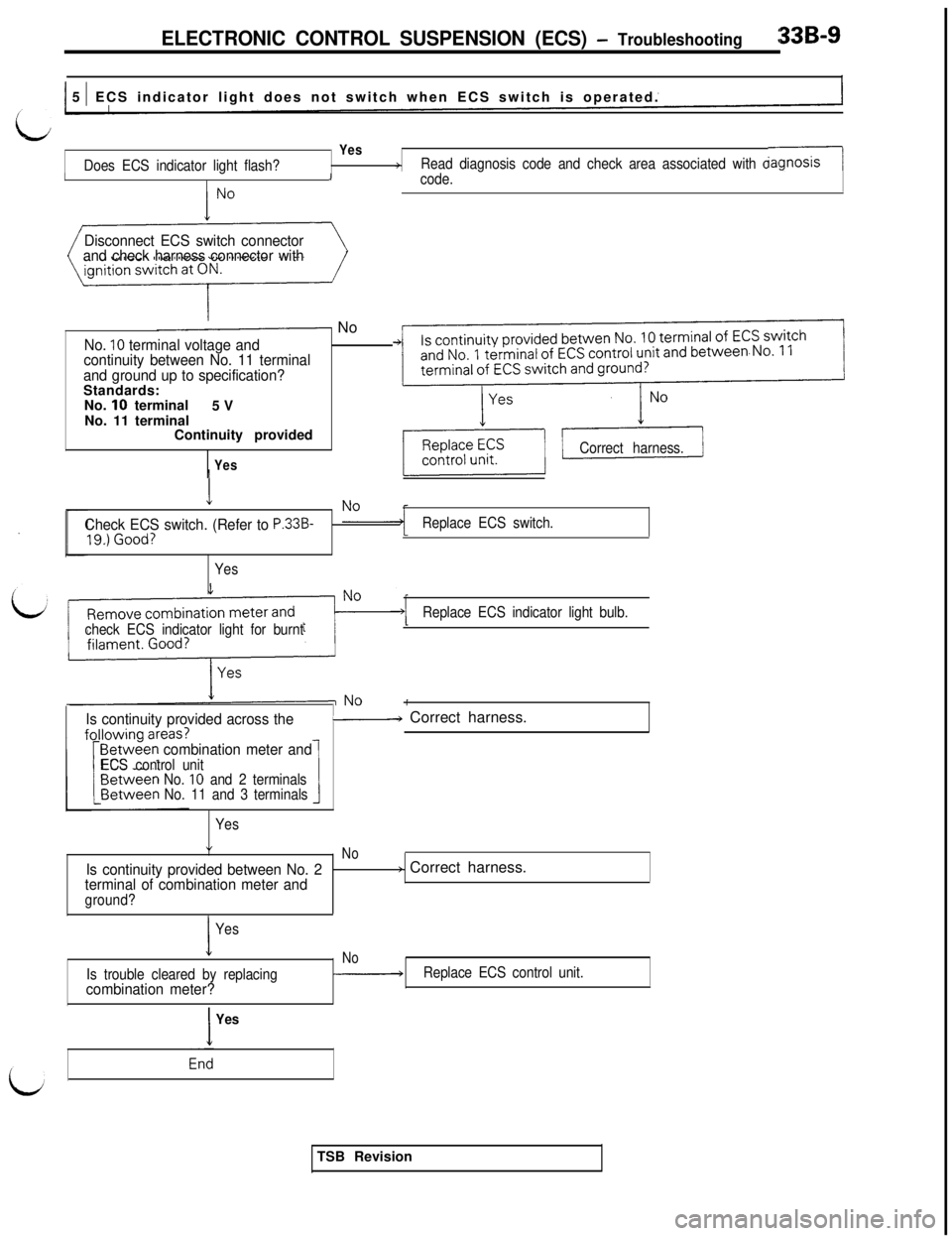
ELECTRONIC CONTROL SUSPENSION (ECS) - Troubleshooting:33B-9
1 5 1 ECS indicator light does not switch when ECS switch is operated.
Yes
Does ECS indicator light flash?+Read diagnosis code and check area associated with dralgnosrs.---IIIcode.
Disconnect ECS switch connector
and check harness connector with
- No
No. 10 terminal voltage and
continuity between No. 11 terminal
and ground up to specification?Standards:
No.
10 terminal
5 V
No. 11 terminal
Continuity provided
YesCorrect harness.
Check ECS switch. (Refer to P.33B-
YesReplace ECS switch.
check ECS indicator light for burntReplace ECS indicator light bulb.
Is continuity provided across the- Correct harness.
combination meter andECS control unit
No. 10 and 2 terminals
No. 11 and 3 terminals
Yes
”No
Is continuity provided between No. 2> Correct harness.
terminal of combination meter andground?
I
Yes
No
Is trouble cleared by replacingcombination meter?
-Replace ECS control unit.
IYesTSB Revision
Page 672 of 1146
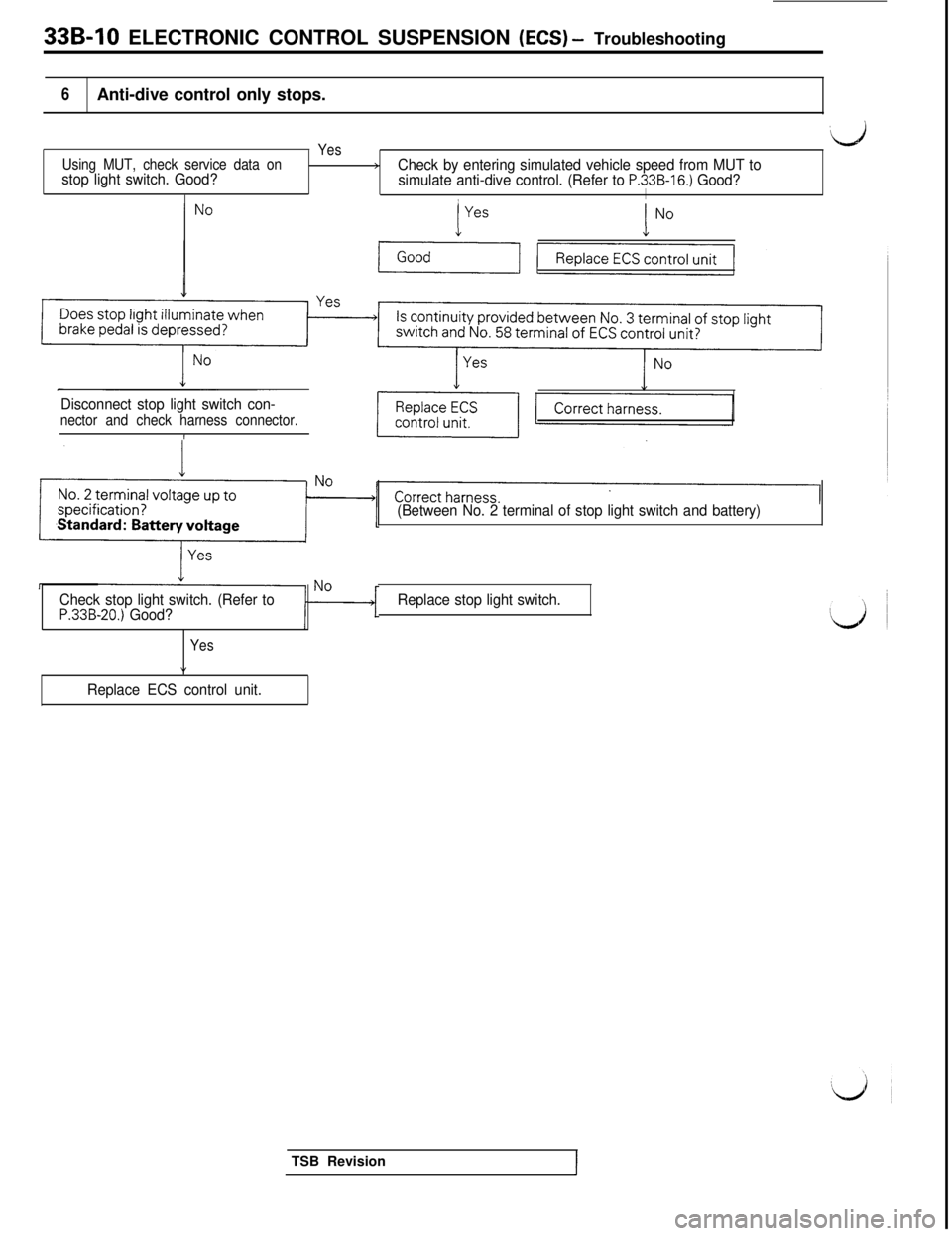
33B-10 ELECTRONIC CONTROL SUSPENSION (ECS) - Troubleshooting
6Anti-dive control only stops.
Yes
Using MUT, check service data on
stop light switch. Good?>Check by entering simulated vehicle speed from MUT to
simulate anti-dive control. (Refer to P.33B-16.) Good?
,I
ch
Disconnect stop light switch con-
nector and check harness connector.f
(Between No. 2 terminal of stop light switch and battery)
Check stop light switch. (Refer to
P.33B-20.) Good?
Yes
”
Replace ECS control unit.Replace stop light switch.TSB Revision
Page 673 of 1146
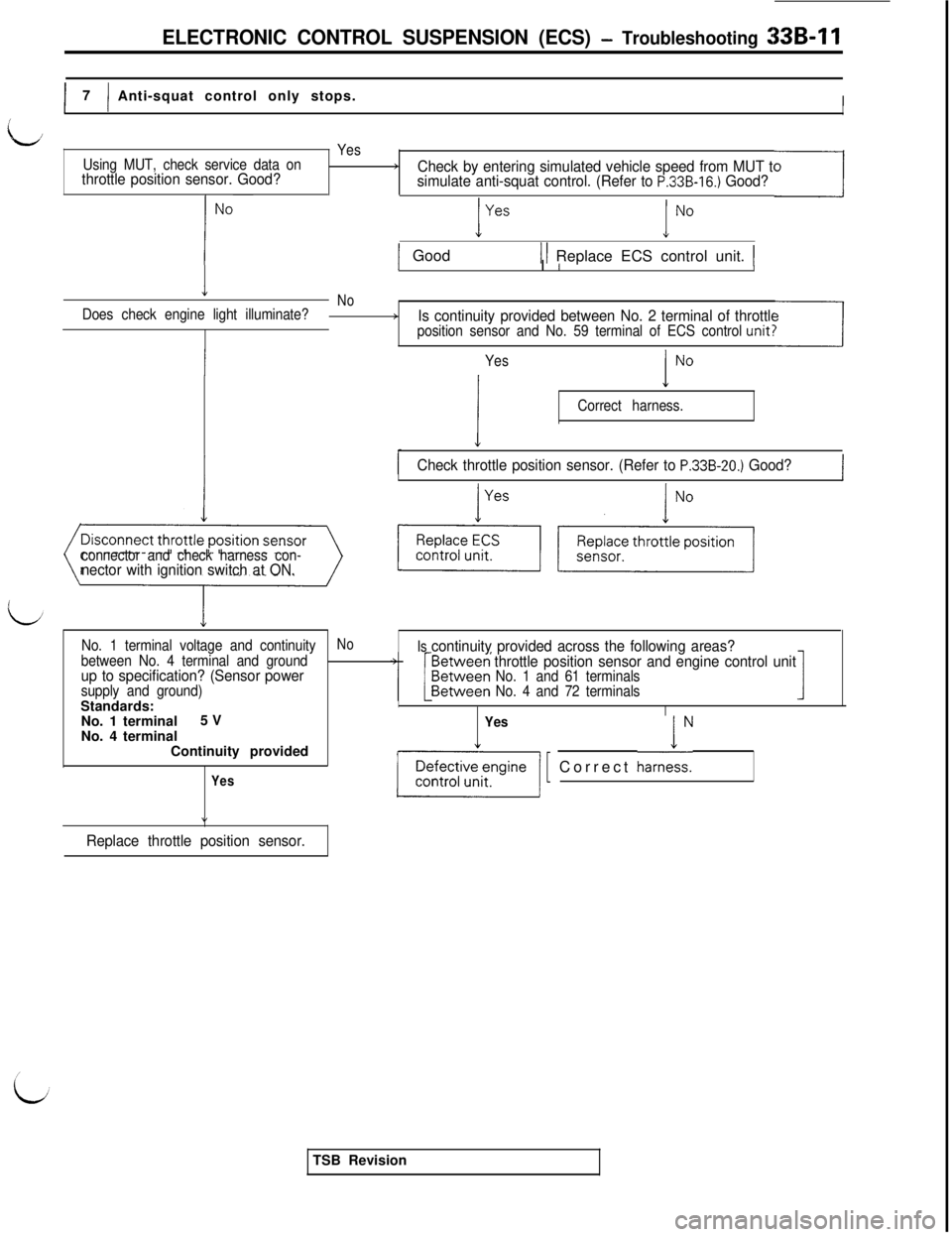
ELECTRONIC CONTROL SUSPENSION (ECS) - Troubleshooting 33B-11
I I7
Anti-squat control only stops.III
L,
I
Using MUT, check service data onthrottle position sensor. Good?
Yes
rCheck by entering simulated vehicle speed from MUT to
simulate anti-squat control. (Refer to P.33B-16.) Good?!
1 Good1 ) Replace ECS control unit. 1
I
1I II
NoDoes check engine light illuminate?>Is continuity provided between No. 2 terminal of throttleposition sensor and No. 59 terminal of ECS controlunityII
Yes
i
Correct harness.
1Check throttle position sensor. (Refer to P.33B-20.) Good?III1
connector and check harness con-nector with ignition switch at ON.
No. 1 terminal voltage and continuityNo
Is
between No. 4 terminal and groundcontinuity provided across the following areas?
up to specification? (Sensor powerthrottle position sensor and engine control unit
No. 1 and 61 terminals
supply and ground)
No. 4 and 72 terminalsStandards:
INo. 1 terminal5 V
YesNo. 4 terminal
Continuity provided
Yes-1 1 Correct harnei:
”
Replace throttle position sensor.TSB Revision
Page 674 of 1146
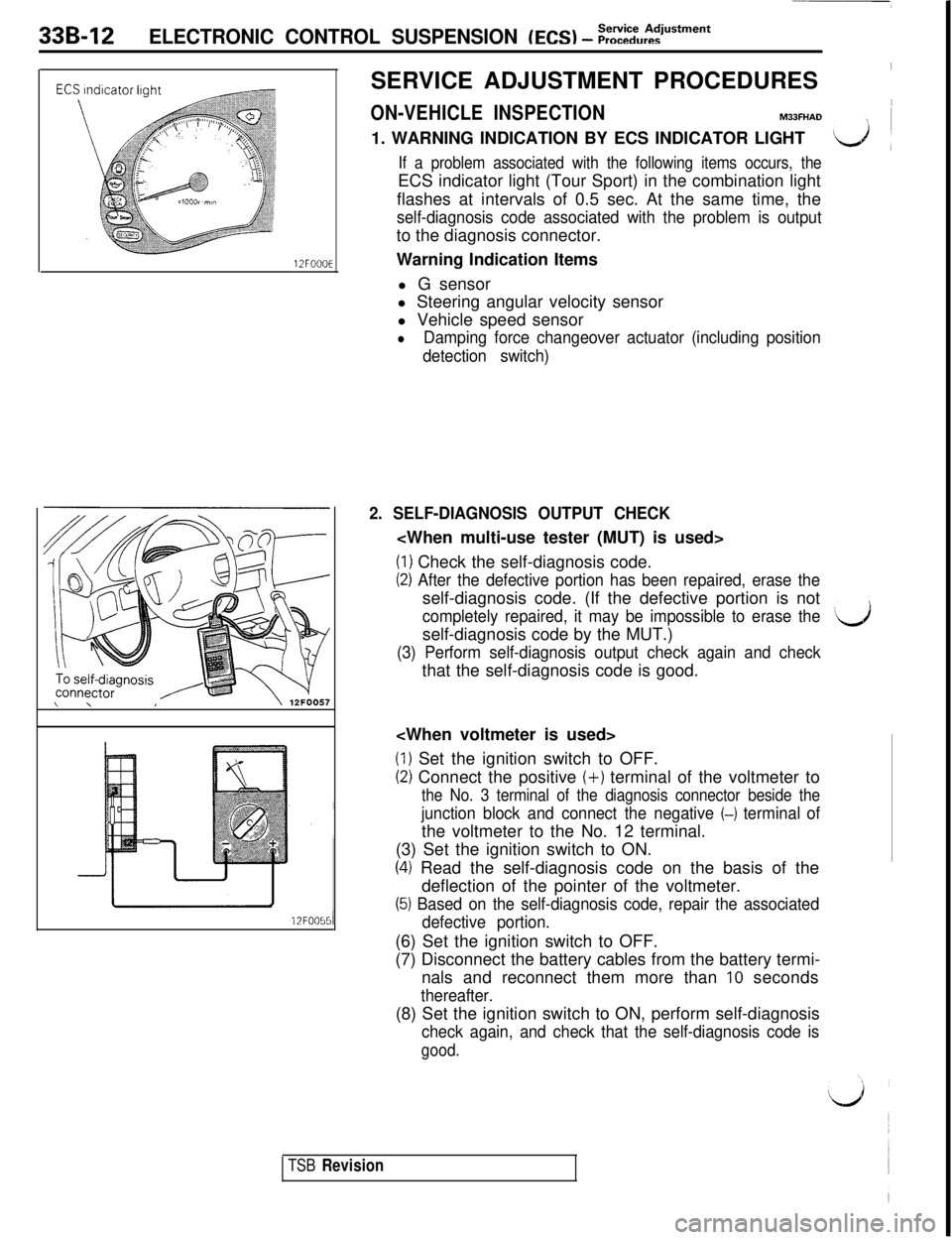
33B-12ELECTRONIC CONTROL SUSPENSION (EC9 - i?:~~u:‘?s*men*
12FOOOESERVICE ADJUSTMENT PROCEDURES
I
ON-VEHICLE INSPECTIONIM33FHAD1. WARNING INDICATION BY ECS INDICATOR LIGHT
If a problem associated with the following items occurs, theECS indicator light (Tour Sport) in the combination light
flashes at intervals of 0.5 sec. At the same time, the
self-diagnosis code associated with the problem is outputto the diagnosis connector.
Warning Indication Items
l G sensor
l Steering angular velocity sensor
l Vehicle speed sensor
lDamping force changeover actuator (including position
detection switch)
2. SELF-DIAGNOSIS OUTPUT CHECK
(I) Check the self-diagnosis code.
(2) After the defective portion has been repaired, erase theself-diagnosis code. (If the defective portion is not
completely repaired, it may be impossible to erase the’self-diagnosis code by the MUT.)d
(3) Perform self-diagnosis output check again and checkthat the self-diagnosis code is good.
(1) Set the ignition switch to OFF.
(2) Connect the positive (+) terminal of the voltmeter to
the No. 3 terminal of the diagnosis connector beside the
junction block and connect the negative (--) terminal ofthe voltmeter to the No. 12 terminal.
(3) Set the ignition switch to ON.
(4) Read the self-diagnosis code on the basis of the
deflection of the pointer of the voltmeter.
(5) Based on the self-diagnosis code, repair the associated
defective portion.(6) Set the ignition switch to OFF.
(7) Disconnect the battery cables from the battery termi-
nals and reconnect them more than
10 seconds
thereafter.(8) Set the ignition switch to ON, perform self-diagnosis
check again, and check that the self-diagnosis code is
good.
TSB Revision
Page 675 of 1146
![MITSUBISHI 3000GT 1991 Service Manual Service AdjustmentELECTRONIC CONTROL SUSPENSION (ECS) - Procedures33B-13Fail Safe and Diagnosis List
Output Code
Diagnosis Item
Fail SafeCode No.Indication Pattern
0[Good]
[Good]
l-l
11G sensor defect MITSUBISHI 3000GT 1991 Service Manual Service AdjustmentELECTRONIC CONTROL SUSPENSION (ECS) - Procedures33B-13Fail Safe and Diagnosis List
Output Code
Diagnosis Item
Fail SafeCode No.Indication Pattern
0[Good]
[Good]
l-l
11G sensor defect](/img/19/57085/w960_57085-674.png)
Service AdjustmentELECTRONIC CONTROL SUSPENSION (ECS) - Procedures33B-13Fail Safe and Diagnosis List
Output Code
Diagnosis Item
Fail SafeCode No.Indication Pattern
0[Good]
[Good]
l-l
11G sensor defective*l Ride controls (pinching and bouncingcontrol, bad road detection control) sl:op.
21Steering angularvelocity sensor open-circuited*
l Anti-roll control stops.
24Vehicle speed sensor*nn open-crrcurtedl Steering stability controls (anti-roll, high
speed sensitive controls) and attitude
controls (anti-dive, anti-squat) stop.l Shock absorber damping force fixed
F. L. damping forcefl-~-~-j 11c$i;z;;Fr actuator
R. R. damping force
I /
64 j-jMJ-~-~-~ ~t$ec~Z$rn&ftYrrZ& /
NOTE(1)Control stop, warning indication and fixed damping force return to normal when the ignition switch is set to OFF.
When any of the problems marked* occurs, if no subsequent problem occurs (for example, when the problem IStransient) normal operation will be restored even if the ignition switch is not set to OFF.(2)Even if control stop warning indication and fixed damping force return to normal as described above, the
self-diagnosis code’is stored in the memory in the ECS control unrt.
(3)The self-diagnosis code can be force-cleared by use of the MUT or by stopping the power supply to the ECS controlunit. In addition
it is automatically cleared if the ON/OFF control of the ignition swatch is repeated 60 times after the
self-diagnosis code has been output, provided that no new self-diagnosis code is output during the period.TSB Revision
Page 676 of 1146
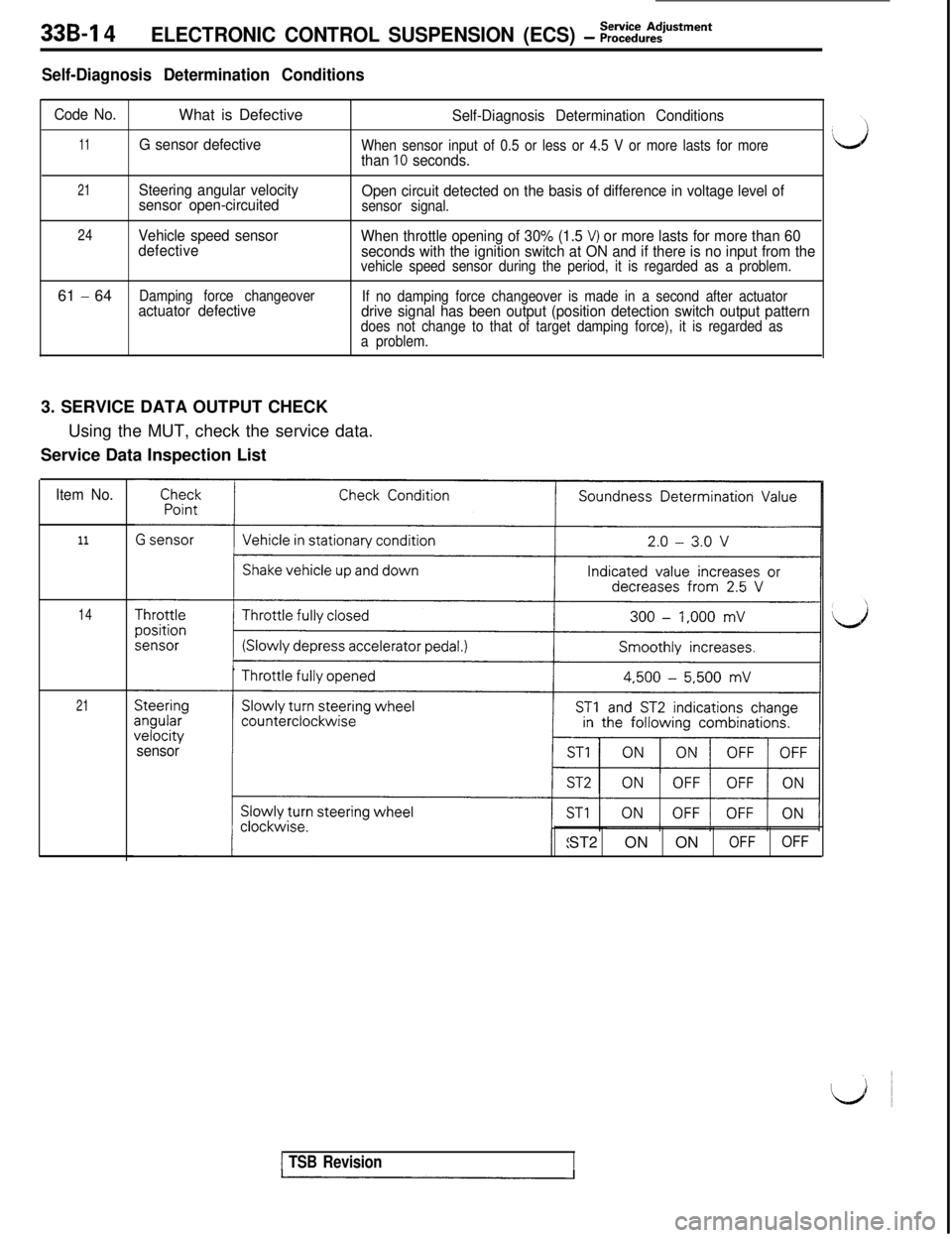
339-l 4ELECTRONIC CONTROL SUSPENSION (ECS) - ~;:i%?tment
Self-Diagnosis Determination Conditions
Code No.What is DefectiveSelf-Diagnosis Determination Conditions
11G sensor defectiveWhen sensor input of 0.5 or less or 4.5 V or more lasts for morethan 10 seconds.
21Steering angular velocity
sensor open-circuitedOpen circuit detected on the basis of difference in voltage level of
sensor signal.
24Vehicle speed sensor
defectiveWhen throttle opening of 30% (1.5 V) or more lasts for more than 60
seconds with the ignition switch at ON and if there is no input from the
vehicle speed sensor during the period, it is regarded as a problem.61
- 64Damping force changeoveractuator defectiveIf no damping force changeover is made in a second after actuatordrive signal has been output (position detection switch output patterndoes not change to that of target damping force), it is regarded as
a problem.3. SERVICE DATA OUTPUT CHECK
Using the MUT, check the service data.
Service Data Inspection List
Item No.
11
14
21
sensorST2 ON ON
OFFOFF
1 TSB Revision
Page 677 of 1146
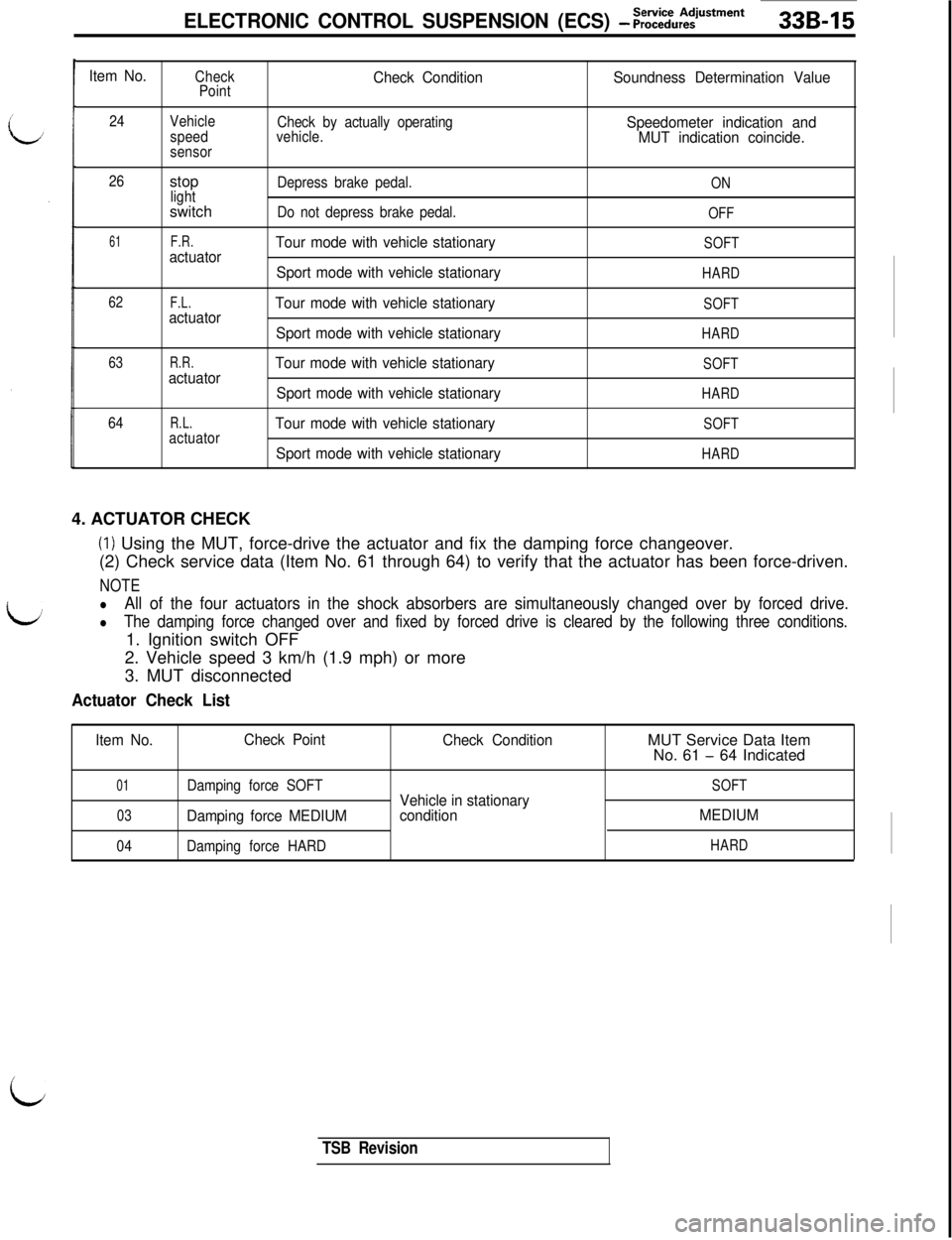
I,
ELECTRONIC CONTROL SUSPENSION (ECS) - ;;~i%:~ustment339-15
Item No.Check
PointCheck ConditionSoundness Determination Value
24
Check by actually operating
vehicle.Speedometer indication and
MUT indication coincide.
26
61
62
63
64Vehicle
speed
sensorstop
lightswitch
F.R.actuator
F.L.actuator
R.R.actuator
R.L.actuatorDepress brake pedal.
ON
Do not depress brake pedal.OFF
Tour mode with vehicle stationarySOFT
Sport mode with vehicle stationaryHARD
Tour mode with vehicle stationarySOFT
Sport mode with vehicle stationaryHARD
Tour mode with vehicle stationarySOFT
Sport mode with vehicle stationaryHARD
Tour mode with vehicle stationarySOFT
Sport mode with vehicle stationaryHARD4. ACTUATOR CHECK
(I) Using the MUT, force-drive the actuator and fix the damping force changeover.
(2) Check service data (Item No. 61 through 64) to verify that the actuator has been force-driven.
NOTE
lAll of the four actuators in the shock absorbers are simultaneously changed over by forced drive.
lThe damping force changed over and fixed by forced drive is cleared by the following three conditions.1. Ignition switch OFF
2. Vehicle speed 3 km/h (1.9 mph) or more
3. MUT disconnected
Actuator Check List
Item No.Check Point
Check ConditionMUT Service Data Item
No. 61 - 64 Indicated
01Damping force SOFT
03Damping force MEDIUM
04Damping force HARD
Vehicle in stationary
conditionSOFT
MEDIUM
HARD
i
TSB Revision
Page 678 of 1146
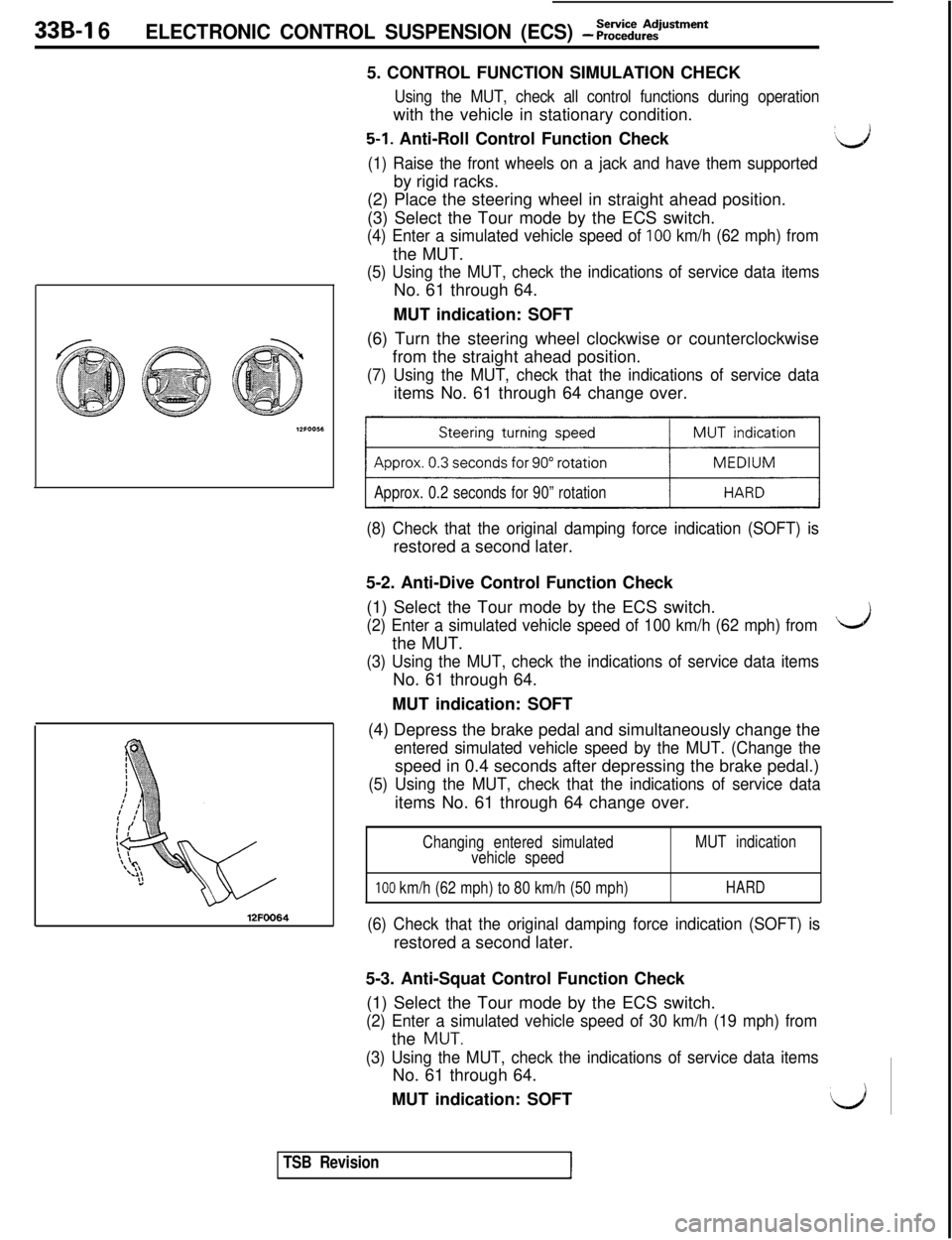
339-l 6ELECTRONIC CONTROL SUSPENSION (ECS) - ;;:%,:?‘Stment5. CONTROL FUNCTION SIMULATION CHECK
Using the MUT, check all control functions during operationwith the vehicle in stationary condition.
5-1. Anti-Roll Control Function Check:d
(1) Raise the front wheels on a jack and have them supportedby rigid racks.
(2) Place the steering wheel in straight ahead position.
(3) Select the Tour mode by the ECS switch.
(4) Enter a simulated vehicle speed of 100 km/h (62 mph) fromthe MUT.
(5) Using the MUT, check the indications of service data itemsNo. 61 through 64.
MUT indication: SOFT
12FOO64(6) Turn the steering wheel clockwise or counterclockwise
from the straight ahead position.
(7) Using the MUT, check that the indications of service dataitems No. 61 through 64 change over.
Approx. 0.2 seconds for 90” rotation
(8) Check that the original damping force indication (SOFT) isrestored a second later.
5-2. Anti-Dive Control Function Check
(1) Select the Tour mode by the ECS switch.
(2) Enter a simulated vehicle speed of 100 km/h (62 mph) fromthe MUT.
(3) Using the MUT, check the indications of service data itemsNo. 61 through 64.
MUT indication: SOFT
(4) Depress the brake pedal and simultaneously change the
entered simulated vehicle speed by the MUT. (Change thespeed in 0.4 seconds after depressing the brake pedal.)
(5) Using the MUT, check that the indications of service dataitems No. 61 through 64 change over.
Changing entered simulated
vehicle speedMUT indication
100 km/h (62 mph) to 80 km/h (50 mph)HARD
(6) Check that the original damping force indication (SOFT) isrestored a second later.
Ls5-3. Anti-Squat Control Function Check
(1) Select the Tour mode by the ECS switch.
(2) Enter a simulated vehicle speed of 30 km/h (19 mph) fromthe
MUT.
(3) Using the MUT, check the indications of service data itemsNo. 61 through 64.
MUT indication: SOFT
l/i
TSB Revision
Page 679 of 1146
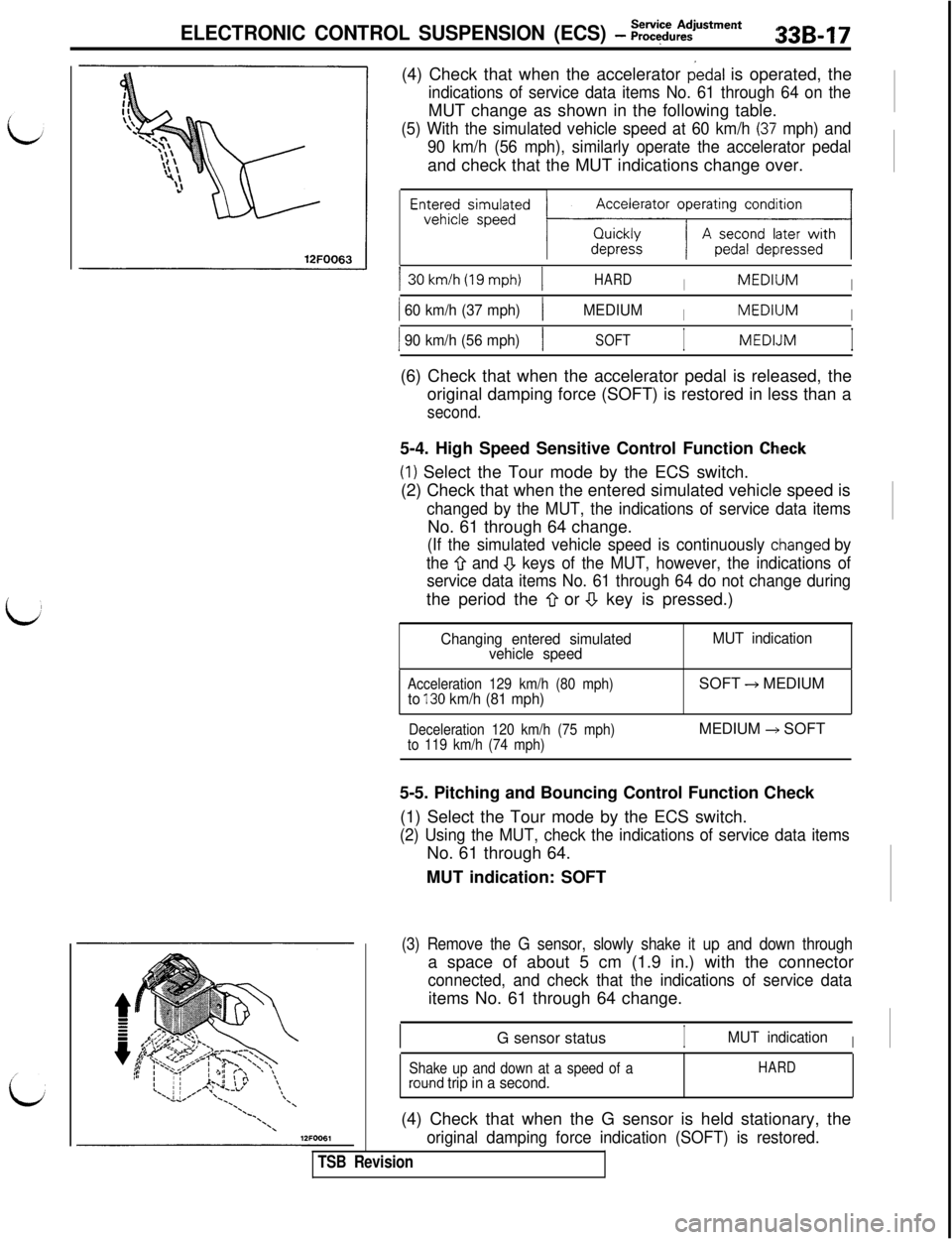
ELECTRONIC CONTROL SUSPENSION (ECS) - :;:~u:~men*33B17(4) Check that when the accelerator
dedal is operated, the
indications of service data items No. 61 through 64 on theMUT change as shown in the following table.
(5) With the simulated vehicle speed at 60 km/h (37’ mph) and
90 km/h (56 mph), similarly operate the accelerator pedaland check that the MUT indications change over.
Accelerator operating condition
EnE~~esismp~~ed ~;zz-KzxJ130km/h(19mph)
1HARDIMEDllJMI
1 60 km/h (37 mph)1MEDIUMIMEDllJMI
1 90 km/h (56 mph)1SOFTIMEDLJMI(6) Check that when the accelerator pedal is released, the
original damping force (SOFT) is restored in less than a
second.5-4. High Speed Sensitive Control Function
Chleck(I) Select the Tour mode by the ECS switch.
(2) Check that when the entered simulated vehicle speed is
changed by the MUT, the indications of service data itemsNo. 61 through 64 change.
(If the simulated vehicle speed is continuously cihanged by
the
Q and .!J keys of the MUT, however, the indications of
service data items No. 61 through 64 do not change duringthe period the
0 or a key is pressed.)
Changing entered simulated
vehicle speedMUT indication
Acceleration 129 km/h (80 mph)to 130 km/h (81 mph)SOFT + MEDIUM
Deceleration 120 km/h (75 mph)
to 119 km/h (74 mph)MEDIUM +, SOFT
5-5. Pitching and Bouncing Control Function Check
(1) Select the Tour mode by the ECS switch.
(2) Using the MUT, check the indications of service data itemsNo. 61 through 64.
MUT indication: SOFT
(3) Remove the G sensor, slowly shake it up and down througha space of about 5 cm (1.9 in.) with the connector
connected, and check that the indications of service dataitems No. 61 through 64 change.
G sensor status
IMUT indicationI
Shake up and down at a speed of arou.nd trip in a second.HARD(4) Check that when the G sensor is held stationary, the
original damping force indication (SOFT) is restored.
TSB Revision
Page 680 of 1146
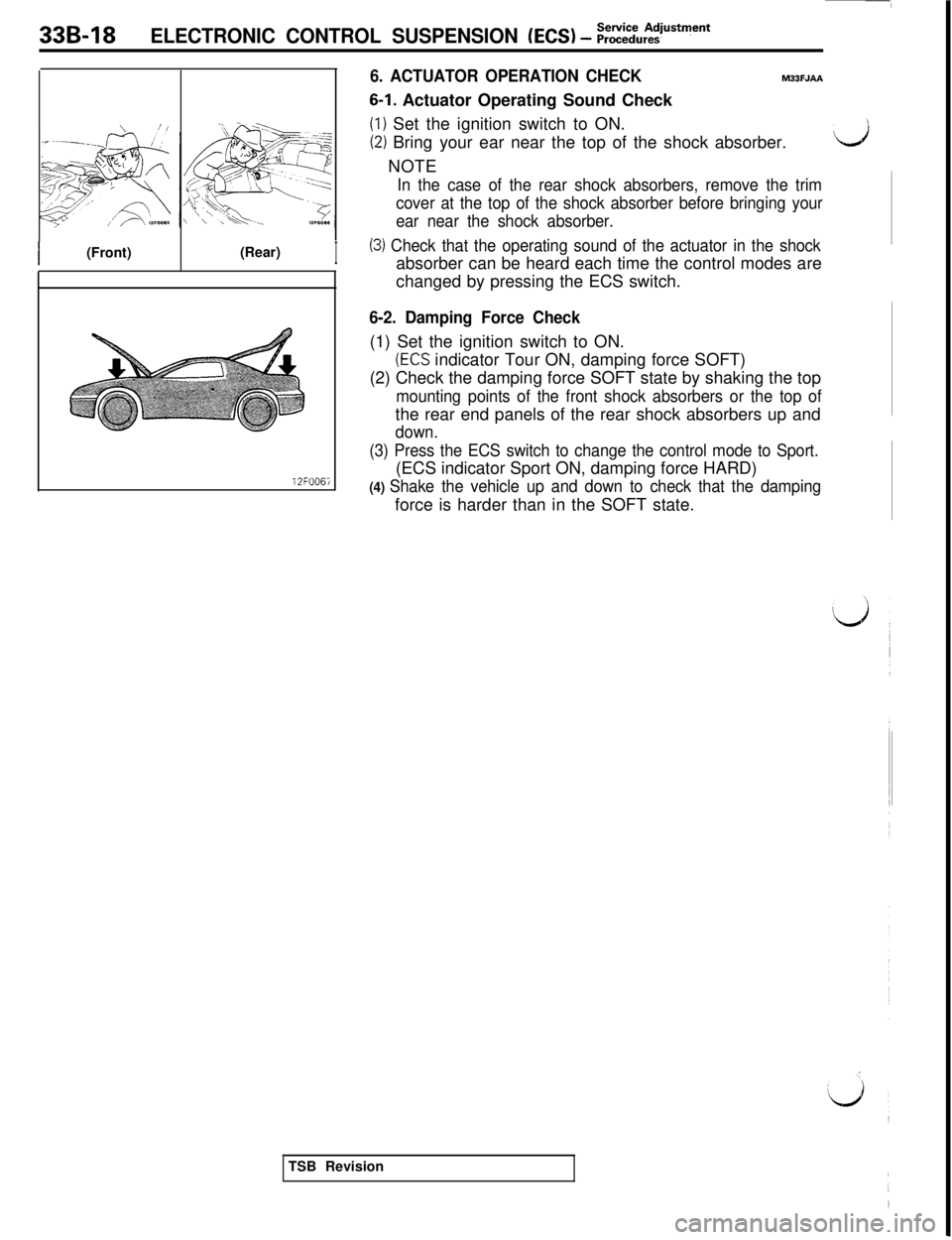
33B-18ELECTRONIC CONTROL SUSPENSION (EC9 - ~::::u:?‘s*men*
\/I
I(Front)(Rear)I
12FOOG
6. ACTUATOR OPERATION CHECKM33FJAA
6-1. Actuator Operating Sound Check
(I) Set the ignition switch to ON.
(2) Bring your ear near the top of the shock absorber.dNOTE
In the case of the rear shock absorbers, remove the trim
cover at the top of the shock absorber before bringing your
ear near the shock absorber.
(3) Check that the operating sound of the actuator in the shockabsorber can be heard each time the control modes are
changed by pressing the ECS switch.
6-2. Damping Force Check(1) Set the ignition switch to ON.
(ECS indicator Tour ON, damping force SOFT)
(2) Check the damping force SOFT state by shaking the top
mounting points of the front shock absorbers or the top ofthe rear end panels of the rear shock absorbers up and
down.
(3) Press the ECS switch to change the control mode to Sport.(ECS indicator Sport ON, damping force HARD)
(4) Shake the vehicle up and down to check that the dampingforce is harder than in the SOFT state.
TSB Revision